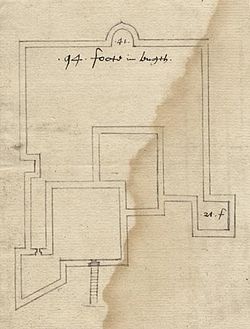Sandown Castle, Isle of Wight
| Sandown Castle | |
| Hampshire | |
|---|---|
 1559 plan of Sandown Castle | |
| Type: | Device fort |
| Location | |
| Grid reference: | SZ603844 |
| Location: | 50°39’24"N, 1°8’49"W |
| Village: | Sandown |
| History | |
| Built 1545 | |
| Information | |
| Condition: | Destroyed |
Sandown Castle was a 'device fort' built at Sandown on the Isle of Wight in Hampshire; one of a series of such forts built at the order of King Henry VIII in 1545 to protect against the threat of French attack.
Constructed from stone with angular bastions, its design was a hybrid of Italian military architectural thinking with traditional English military design. The site was raided by a French force that summer while the fortification was still being constructed. The site suffered from coastal erosion and the castle was demolished in 1631.
History
16th century
Sandown Castle was built following the breach with the Papacy: the Pope urged France and the Holy Roman Empire to attack England, and so in 1539 King Henry ordered a series of new forts, through an instruction called a "device" and another device was issued in 1544 to further improve the country's defences, particularly along the south coast.[1]
Sandown's device fort was built between April and September 1545 to protect the south-east coast of the Isle of Wight. Sandown Castle overlooked Sandown Bay.[2] It was constructed by the Italian engineer Giovanni Portinari and the surveyor William Ridgeway, at a cost of £2,400.[3][4][5]
Designed around a central courtyard, it had a square tower and two angular bastions on one side, and a circular bastion looking out to sea.[6] The rear of the stone defences was protected by a moat, and the castle had a wooden pier for boats to dock at.[7][8]
The angular bastions echoed contemporary Italian thinking on military architecture, and may have been influenced by Richard Lee, the King's Surveyor of Works, as well as by Portinari's own continental background.[9] Despite being relatively advanced for an English fortification, the castle did not feature the more fashionable Italianate "arrow-head" bastion design used at nearby Yarmouth Castle and has been critiqued by historians: Andrew Saunders describes it as an imperfect "hybrid" of English and continental ideas, John Hale as a timid, confused flirtation with modern designs.[10][11][12]
Before the castle could be completed, however, the French attacked. Admiral Claude d'Annebault crossed the Channel and arrived off the Solent with 200 ships on 19 July. 2,000 French soldiers men landed on the Isle of Wight and attacked Sandown, where labourers were still present.[13] Their advance soon stalled, however, and the French retreated back to their fleet, bringing the invasion threat to an end; the castle was finally completed after their departure.[13]
17th century
By the 17th century, coastal erosion had undermined the castle's walls.[14] In 1627, Charles I announced that he would repair the fortification but instead the ruins were dismantled in 1631 by Sir John Oglander.[14] A new fortification, Sandown Fort was built in its place, positioned further inland, but the possible remains of the foundations of the original castle are still visible along the shore at low tide.[15][16][17]
References
- ↑ Harrington 2007, pp. 29–30
- ↑ Harrington 2007, pp. 8, 31–32
- ↑ Harrington 2007, pp. 8, 31–32
- ↑ Saunders 1989, p. 51
- ↑ National Monuments Record: No. 461937 – Sandown Castle
- ↑ Harrington 2007, p. 32
- ↑ Harrington 2007, p. 32
- ↑ A History of the County of Hampshire - Volume 5 pp 156-170: Parishes: Brading (Victoria County History)
- ↑ Harrington 2007, pp. 15–16, 32; Hale 1983, p. 90
- ↑ Harrington 2007, p. 32
- ↑ Hale 1983, pp. 89–90
- ↑ Saunders 1989, p. 51
- ↑ 13.0 13.1 Harrington 2007, p. 46
- ↑ 14.0 14.1 A History of the County of Hampshire - Volume 5 pp 156-170: Parishes: Brading (Victoria County History)
- ↑ A History of the County of Hampshire - Volume 5 pp 156-170: Parishes: Brading (Victoria County History)
- ↑ National Monuments Record: No. 461937 – Sandown Castle
- ↑ Adams 1884, p. 200
Bibliography
- Adams, W. H. Davenport (1884). Isle of Wight: Its History, Topography and Antiquities (new and revised ed.). London, UK: T. Nelson and Sons. OCLC 264864979. https://archive.org/details/isleofwightitshi00adam.
- Biddle, Martin; Hiller, Jonathon; Scott, Ian; Streeten, Anthony (2001). Henry VIII's Coastal Artillery Fort at Camber Castle, Rye, East Sussex: An Archaeological Structural and Historical Investigation. Oxford, UK: Oxbow Books. ISBN 0904220230.
- Hale, J. R. (1983). Renaissance War Studies. London, UK: Hambledon Press. ISBN 0907628176.
- Harrington, Peter (2007). The Castles of Henry VIII. Oxford, UK: Osprey Publishing. ISBN 9781472803801.
- King, D. J. Cathcart (1991). The Castle in England and Wales: An Interpretative History. London, UK: Routledge Press. ISBN 9780415003506.
- Morley, B. M. (1976). Henry VIII and the Development of Coastal Defence. London, UK: Her Majesty's Stationery Office. ISBN 0116707771.
- Potter, Henry (2011). Henry VIII and Francis I: The Final Conflict, 1540–47. Leiden, the Netherlands: Koninklijke Brill NV. ISBN 9789004204317.
- Saunders, Andrew (1989). Fortress Britain: Artillery Fortifications in the British Isles and Ireland. Liphook, UK: Beaufort. ISBN 1855120003.
- Thompson, M. W. (1987). The Decline of the Castle. Cambridge, UK: Cambridge University Press. ISBN 1854226088.
| Henry VIII's Device Forts on the south coast |
|---|
|
Kent: Sandown Castle • Deal Castle • Walmer Castle • Sandgate Castle • Sussex: Camber Castle • Hampshire: Southsea Castle • Hurst Castle • Calshot Castle • Cowes Castle • Yarmouth Castle • Netley Castle • St Andrew's Castle • Dorset: Portland Castle • Sandsfoot Castle • Cornwall: Pendennis Castle • St Mawes Castle |